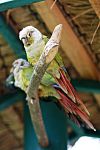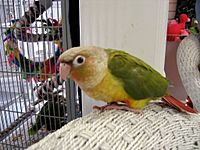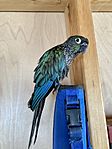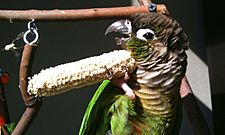Green-cheeked parakeet facts for kids
Quick facts for kids Green-cheeked parakeet |
|
|---|---|
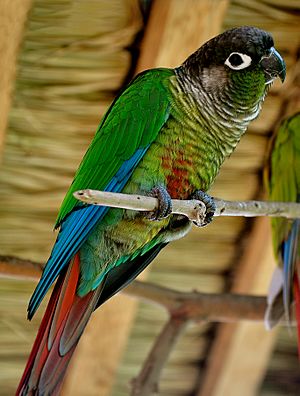 |
|
| Kuala Lumpur Bird Park, Malaysia River Safari, Singapore | |
| Conservation status | |
| Scientific classification | |
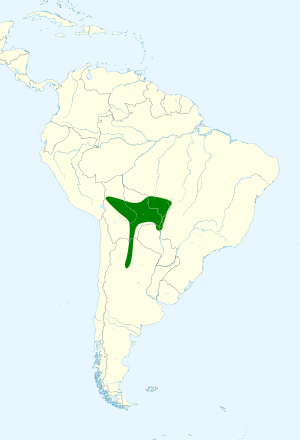 |
|
| Green-cheeked parakeet range |
The green-cheeked parakeet (Pyrrhura molinae) is a small, colorful bird. It is also called the green-cheeked conure by people who keep birds as pets. This parakeet belongs to the parrot family, which includes parrots from Africa and the Americas. You can find these birds living in the wild in countries like Argentina, Bolivia, Brazil, and Paraguay.
Contents
Types of Green-Cheeked Parakeets
There are six different types, or subspecies, of the green-cheeked parakeet. These types are slightly different from each other, often in their colors or where they live.
Some of these subspecies include:
- P. m. flavoptera
- P. m. molinae
- P. m. phoenicura
- P. m. hypoxantha
- P. m. restricta
- P. m. australis
Scientists once thought one type, P. m. hypoxantha, might be a separate species. However, they are now sure it is a subspecies. The green-cheeked parakeet is closely related to other parakeets. These include the maroon-bellied, pearly, and crimson-bellied parakeets.
What Green-Cheeked Parakeets Look Like
Green-cheeked parakeets are about 25 to 26 centimeters (10 inches) long. They weigh between 62 and 81 grams (about 2 to 3 ounces). Both male and female birds look the same.
The most common type, P. m. molinae, has a dull brown color on its head. Its cheeks are green, and it has a creamy white ring around its eyes. The top part of its body is green. Its throat and neck sides are scaly brown and whitish. The belly is a dull reddish color. Its wings are mostly green with blue flight feathers. The tail is a dull reddish color. Young birds look similar but do not have the red belly yet.
Other types have small differences:
- P. m. phoenicura has green at the base of its tail.
- P. m. restricta has a blue collar and a smaller red belly patch.
- P. m. hypoxantha has a lighter head and less scaly chest. Some of these birds can even have mostly yellow underparts.
- P. m. australis is paler and has a larger red belly patch.
- P. m. flavoptera has orange or red on its wing bend.
Where Green-Cheeked Parakeets Live
These parakeets live in different parts of South America. Each subspecies lives in a specific area:
- P. m. flavoptera lives in west-central Bolivia.
- P. m. molinae lives in Bolivia.
- P. m. phoenicura lives in northeastern Bolivia and southwestern Brazil.
- P. m. hypoxantha lives in eastern Bolivia, southwestern Brazil, and northern Paraguay.
- P. m. restricta lives in central Bolivia.
- P. m. australis lives from southern Bolivia into northwestern Argentina.
Green-cheeked parakeets prefer to live in lowland forests and woodlands. They can also be found in areas where forests are growing back. They live in humid forests up to 2,000 meters (about 6,500 feet) high.
Behavior of Green-Cheeked Parakeets
Movement
Green-cheeked parakeets that live in higher places move to lower areas during the winter. This helps them find food and warmer weather.
Feeding
These birds eat many different things in the wild. Their diet includes fruits, seeds, and flowers. They also eat some nectar and leaves.
Reproduction and Life Cycle
In Argentina, green-cheeked parakeets breed in February. Their breeding season in other areas is not fully known. They build their nests inside holes in trees.
When kept as pets, female parakeets lay four to six eggs. Both parents take turns sitting on the eggs for 22 to 25 days. The young birds leave the nest about seven weeks after hatching.
Vocalization
When flying, green-cheeked parakeets make high-pitched, grating sounds. They often make these sounds in fast bursts, like "krree krree krree." They can also make single "kuree" notes. When they are resting on a branch, they make more pleasant, two-syllable notes like "rrekeet" or "keew." However, perched birds are often quiet. When many birds fly together, they make a loud, harsh, and piercing chattering sound.
Conservation Status
The IUCN (International Union for Conservation of Nature) says the green-cheeked parakeet is of "Least Concern." This means they are not currently in danger of disappearing. They live in a large area, but their exact number is unknown. Scientists believe their population might be getting smaller. However, there are no immediate threats to them right now. They are common in most places where they live.
Green-Cheeked Parakeets as Pets
Green-cheeked parakeets are very popular pets. They are known for being playful, loving, and smart. People often say they have a "big personality in a small body." They can learn to talk, but their vocabulary is usually small. Their voice might sound a bit rough.
These birds often like to be held. They can also learn fun tricks. Some tricks include lying on their backs, giving "kisses," shaking, and hanging upside down. They can even learn to use simple tools or be potty trained. Green-cheeked parakeets are not usually very loud. This makes them good pets even for people living in apartments. They are known as the quietest of the conure parrots. They can learn tricks and a few words with lots of training. Sometimes, especially when young, they might bite. But with patience, owners can help them stop this behavior.
If cared for well, green-cheeked parakeets can live for 25 to 30 years as pets. However, many only live for about 10 years. This is often because they are not cared for properly or do not get the right food.
Color Variations in Pets
Besides their natural colors, people have bred green-cheeked parakeets to have new color patterns. These are called "color variations":
- Cinnamon parakeets are lime green and have lighter colors. Their head is tan, and their tail feathers are a lighter maroon.
- Yellow-sided parakeets have bright chests that change from red to yellow. They have dark gray heads. Sometimes, they have a bright yellow feather on each upper wing. This is rare and makes them more valuable.
- Pineapple parakeets are a mix of cinnamon and yellow-sided types. They have a bright chest, a tan head, and lime green feathers on their back. Their tail feathers are like the yellow-sided type, giving them a "halo" look.
- Turquoise parakeets have blue-green and green feathers on their body. The tips of their wing feathers look very shiny if not clipped. Their chest feathers are grayish, and their tail feathers are gray.
- Other less common colors like green, red, and blue apple varieties have also been seen.
See also
 In Spanish: Cotorra de Molina para niños
In Spanish: Cotorra de Molina para niños




